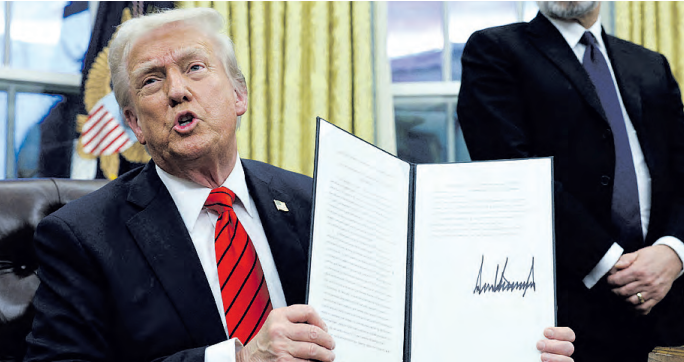

On February 1, 2024-25, President Donald Trump signed an executive order imposing a 10 per cent tariff on goods imported from China and 25 per cent on goods from Canada and Mexico.
While the tariffs on Canada and Mexico were temporarily paused, the move received worldwide opposition, especially considering the fragile global economic state following the last trade war.
In retaliation, China imposed its own tariffs, including 15 per cent duties on US coal and liquefied natural gas, and 10 per cent on crude oil, agricultural machinery, and vehicles. Additionally, China restricted access to critical minerals essential for defence and technology, such as tungsten and gallium, in response to US protectionist policies.
This escalation has evolved into a tit-for-tat trade war, further destabilising the global trade environment.
Washington appears concerned about China’s growing global influence, taking a protectionist stance to curb Beijing’s rise, even as multilateralism gains wider acceptance worldwide.
A renewed US-China trade conflict echoes the first-term tensions that impacted the global economy, without diminishing China’s international standing.
However, when it comes to tariffs, there are no winners, as consumers from both sides suffer due to rising commodity prices.
Trump claims the tariffs will raise revenue from non-US individuals and entities. However, this is misleading.
Tariffs are paid by importers, not exporters, and although the latter may offer some price concessions, the US is no longer a dominant buyer of the world’s goods and services.
It is therefore unlikely to receive significant price reductions for goods it was acquiring cheaply anyway, especially as alternative markets are available.
While Trump has resorted to tariffs and quotas as an economic policy to make America “great again”, the move is a double-edged sword.
It forces countries targeted by tariffs to adapt to the tense environment and become more innovative.
History shows protectionist policies are often counterproductive, strengthening the very nations they aim to weaken.
In China’s case, the US tariffs have accelerated its economic development and reduced its reliance on the US, ultimately boosting China’s global competitiveness.
China’s resilience remains strong for several reasons.
As the world’s second-largest economy and a top trading partner for more than 120 countries, China’s connections to major economies such as Japan, South Korea, Russia, and the European Union enable it to effectively counter US tariffs and sanctions.
China’s strategic outreach also includes forming alliances with European countries, traditionally aligned with the US, to bolster its economic and security resilience.
Ironically, while the West once championed globalisation, it now turns to protectionism in response to China’s rise.
However, the momentum of multilateralism is unstoppable, and US efforts to curb it may only slow, but not halt, China’s progress.
The ‘Made in China 2025’ plan launched in 2015, aimed to reduce China’s dependence on foreign technology, a goal many Chinese scholars believe has largely been achieved.
Over the past two decades, China has attracted key upstream players, and by 2010, it overtook the US to become the world’s largest value-added manufacturer, accounting for 28 per cent of global production by 2018.
China’s rise was fuelled not just by its size and low labour costs, but also by significant investments in education and skilled talent.
In September of this year, Apple CEO Tim Cook acknowledged that China’s extensive pool of skilled workers is crucial for the complex manufacturing processes that Apple products require, adding that China stopped being a low-labour-cost country years ago.
China’s strong and efficient supply chains have demonstrated resilience, backed by heavy investments in infrastructure, logistics, and manufacturing.
By diversifying its supply chains, Beijing reduces its dependence on any single country or region, enhancing its ability to withstand economic pressures from the US.
Despite some shifts in global supply chains to countries like Vietnam, China retains a substantial share of labour-intensive exports, from 18 per cent in late 2017 to 17 per cent in 2023.
As the largest developing nation, China’s post-pandemic resilience and technology-sharing commitments continue to benefit many developing countries, particularly in Africa through the Forum on China-Africa Cooperation and similar initiatives.
China’s Belt and Road Initiative, connecting China’s industrial capacity to emerging markets worldwide, including BRICS and ASEAN countries, presents an opportunity to offset the effects of an aging population and sustain economic growth.
China’s manufacturing sector, accounting for nearly 30 per cent of its economy, has maintained its position as the world’s largest manufacturing economy since 2010.
Data from the United Nations Statistics Division reveals that China produced 28.7 per cent of global manufacturing output in 2019, well ahead of the US.
As China’s economy grows, its industrial base continues to support global consumers with affordable goods, from electronics to everyday products.
China’s meteoric rise has sparked alarm among many nations, prompting geopolitical tensions and efforts to undermine Beijing.
Since
1949, the leadership of the Communist Party of China has provided
consistent direction for the country’s
economic growth, fostering stability
and national cohesion.











